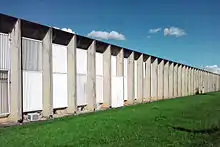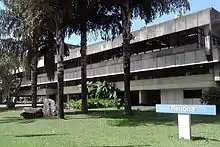University of Brasília
The University of Brasília (Portuguese: Universidade de Brasília, UnB) is a federal public university in Brasília, the capital of Brazil. It was founded in 1960 and has since consistently been named among the top five Brazilian universities and the top twenty universities in South America by Times Higher Education (THE).
Universidade de Brasília | |
.svg.png.webp) | |
Other names | UnB |
|---|---|
| Motto | Autonomy |
| Type | Public university |
| Established | April 21, 1962 |
| Rector | Márcia Abrahão |
Academic staff | 2,241[1] |
Administrative staff | 2,512[2] |
| Undergraduates | 28,570[3] |
| Postgraduates | 6,304[3] |
| Location | , , Brazil |
| Campus | Urban, 3,950,579 m2 (42,523,680 sq ft) |
| Colors | green and blue |
| Website | www.unb.br |
It admits undergraduate and post-graduate students via an yearly entrance exam, known in Brazil as vestibular and through ENEM and is most renowned for its courses in economics, international affairs, law, anthropology, mathematics and political science. Its Central Library is home to Midwestern Brazil's largest archive.
UnB offers 114 courses recognized by the Ministry of Education.[4]
History


The University of Brasilia Foundation was founded on December 15, 1961. Professor Darcy Ribeiro, who became its first leader, was one of the most enthusiastic supporters of its creation. Architect Oscar Niemeyer designed its main building, the 700 m long Instituto Central de Ciências (ICC), nicknamed Minhocão.
The institution was created on April 21, 1962 by educator Anísio Teixeira and anthropologist professor Darcy Ribeiro. As of 2010, it employed 1,757 faculty and 2,391 servants, and had over 30,000 graduate and undergraduate students. Each semester, the University of Brasília accepts nearly 2,000 incoming students for its 61 undergraduate programs. On the graduate level, the university offers 49 master's degrees and 27 doctoral programs.
Academics
The university was one of the first in Brazil to admit students via Programa de Avaliação Seriada (PAS), an alternative evaluation which tests high school students once a year bypassing vestibular.
Each semester, the University of Brasília accepts nearly 2,000 incoming students from a pool of approximately 25,000 candidates for its 61 daytime or evening undergraduate programs. At the graduate level, the university offers 56 masters programs and 31 doctorate programs. It also offers advanced non-degree programs, many of them conducted in other Brazilian States, such as Bahia, Amazonas, Rondônia, Goiás and Rio Grande do Norte. The Technological and Scientific Development National Council (CNPq) and the Coordination for the Improvement of Higher Education Personnel (CAPES) support most of these courses, offering scholarships and research grants.
Distance education is an expanding activity in UnB, being managed by the Center for Open, Continuous and Long Distance Education (CEAD) and the School of Education. The United Nations Educational, Social and Cultural Organization (UNESCO) sponsors the Long Distance Education chair at UnB.[5]
Ranking
Several of University of Brasília's graduate programs have been graded 6 and 7 (in a scale from 1 to 7) in the annual CAPES assessment, including its courses in anthropology, mathematics, geology, economics, law, among others. Its programs in economics, international relations and political science are ranked first among public universities in the country.
The University of Brasilia has been ranked one of the top five public universities in Brazil by Editora Abril's Guia do Estudante. It ranks eighth in the list of the best universities in the country.[6]
Campus
UnB is located in the Brasília administrative region of the Federal District of Brazil, on the northwestern bank of Paranoá Lake. Most of its buildings were designed in a modernist architecture style.
UnB's Central Library owns the largest archive in Centerwestern Brazil. It maintains a university restaurant, as well as Fazenda Água Limpa, a farm in the outskirts of the Federal District where ecological, agricultural and forestry research is conducted.
Buildings
The university hosts:
- 22 institutes,
- 50 departments,
- 16 scientific, technological, cultural, artistic and general service centers,
- student and staff residences,
- a hospital,
- a sports center,
- a seismological observatory,
- physical experiment facilities, including plasma, liquid crystals, complex fluids and optical spectroscopy,
- an animal research laboratory,
- a library, the Central Library
- a student restaurant,
- the rectory building
- a farm for ecological, agricultural and forestry research, and
- an ecological station.
Community involvement
The university runs 115 community outreach projects, offering a total of 438 courses and events. Involving the direct participation of 240 professors and 65,132 students, these activities reach nearly 185,000 people in the Federal District and surrounding region in Goiás and Minas Gerais.
Outreach activities include the Future with Art, Culture and Sport (FACE) program; the Community Initiatives Advisory Program (PRATICOM); the Program for Worker and Trade Union Leadership Training (PROSINT); the Rural Development Program and the Model Office for Legal Assistance. University members also offer consulting and assistance to the Community Health Training Program (PACs).
Research
More than 260 research-groups work in more than 400 laboratories. This research is supported by the Technological and Scientific Initiation Program (PIBIC) and the Special Training Program (PET), which also offers scholarships to gifted undergraduates. Among other federal and state agencies, programs are funded by CNPq, CAPES, the Research and Projects Funding Program (FINEP), the Technological and Scientific Development Support Program (PADCT) and the Federal District Research Support Foundation (FAPDF).

Other organisations active in the research area are the International Center for Condensed Matter Physics (CIFMC), the cbsp.unb.br [Brazilian Center for Protein Sequencing (CBSP)], the Center for Maintenance of Equipment (CME) and the university Herbarium. The Technological Development Center (CDT) works to integrate the University to the business world, maintaining a small business start-up program and other types of consulting assistance to business.
Programa de Avaliação Seriada
The Continuing Evaluation Program (Portuguese: Programa de Avaliação Seriada) evaluates high school students interested in enrolling on a yearly basis during their three years of high school, in addition to the traditional Brazilian vestibular and the national ENEM exam. The university prefers this system to single entrance examinations.
Rankings
| University rankings | |
|---|---|
| Global – Overall | |
| THE World[7] | 801–1000 (2018) |
In 2017, Times Higher Education ranked the university within the 801–1000 band globally.[7]
International students
The university accepts international students through:
- Exchange programs for international students from academic institutions and organizations that have an exchange agreement with the university. The program lasts from six months to one year.
- Undergraduate Students’ program (PEC-G – Programa de Estudante Convênio de Graduação) is for students from university institutions of developing countries that have developed activities in cooperation with the Brazilian government. Students from Latin America, Africa and Asia are the biggest partners of the UnB in this project.
- Post-Graduate program (PEC-PG – Programa de Estudante Convênio de Pós-Graduação) is through the Brazilian embassies abroad. The objective is to promote the qualification of senior staff of developing countries, by offering master's and doctorate degrees.
- The Federal Constitution International Affairs program accepts diplomats who are working in Brasília and their legal dependents.
Notable alumni and faculty
Alumni[8]
- Alexandre Tombini, President of the Central Bank of Brazil,
- Ana Paula Padrão, journalist, former anchor of Jornal da Globo, now at Band,
- Gilmar Mendes, justice of the Brazilian Supreme Court, former President of the Supreme Court,
- Ítalo Fioravanti Sabo Mendes, judge of the Regional Federal Court of the 1st Region,
- Helena Chagas, Secretary of Social Communication of the Presidency of Brazil,
- Henrique Malvar, managing director of Microsoft Research's largest laboratory in Redmond, Washington, USA.,
- Izabella Teixeira, Ministry of the Environment,
- Joaquim Barbosa, Justice of the Brazilian Supreme Court, and former President of the Supreme Court,
- Eliane Cantanhêde, economy and political Folha de S. Paulo columnist,
- Maria Paula, comedian, actress, and TV personality
- Míriam Leitão, TV Globo journalist.
- Fernando Collor de Mello, 32nd President of Brazil.
Faculty
- Oscar Niemeyer, architect, Pritzker Prize 1988, and founder
- Athos Bulcão, visual artist and founder
- Cyro dos Anjos, writer
- Roberto Saturnino Braga, engineer and politician.
- Cristovam Buarque, mechanical engineer and politician, former governor of the Federal District, former senator, former Rector, and economics professor
- Claudio de Moura Castro, economist, educator, and columnist.
- Cesar da Sá, biochemist, lecturer, Pasteur Institute, Paris, and University of California, San Diego
- Nelson Pereira dos Santos, film director.
- Teotonio Vilela Filho, politician, economist, current governor of Alagoas.
- Otto Richard Gottlieb, chemist, Nobel Prize in Chemistry nominee.
- Darcy Ribeiro, anthropologist, one of the founders of the University of Brasília.
- Roberto Aureliano Salmeron, nuclear physicist.
- Cláudio Santoro, composer and violinist.
- Anísio Teixeira, educator, founder.
- Antônio Augusto Cançado Trindade, jurist, "full professor" at UnB, elected judge of the International Court of Justice, professor of International Relations.
- Francisco Rezek, former Justice of the Brazilian Supreme Court, former judge of the International Court of Justice (1996–2006), professor of Law.
- Gilmar Mendes, Justice of the Brazilian Supreme Court, former President of the Supreme Court, professor of Law.
- Ítalo Fioravanti Sabo Mendes, judge of the Regional Federal Court of the 1st Region, professor of Law.
- Jorge Antunes, composer
- Marcos Bagno, linguist and translator
- Marisa von Bülow, political scientist and sociologist
References
- "UnB Portal – Academic Staff" (in Portuguese). Archived from the original on January 10, 2013.
- "UnB Portal – Technical and Administrative Staff" (in Portuguese). Archived from the original on January 10, 2013.
- "UnB Portal – Registered Students (in Portuguese)". Archived from the original on January 10, 2013.
- "Faculdades reconhecidas pelo MEC, Vestibular, Apostilas, Universitário, Profissão, professor". Retrieved July 5, 2015.
- "UnB – Universidade de Brasília". Retrieved July 5, 2015.
- "Guia do Estudante". Retrieved July 5, 2015.
- World University Rankings 2017–2018
- http://www.alumni.unb.br
External links
| Wikimedia Commons has media related to University of Brasília. |